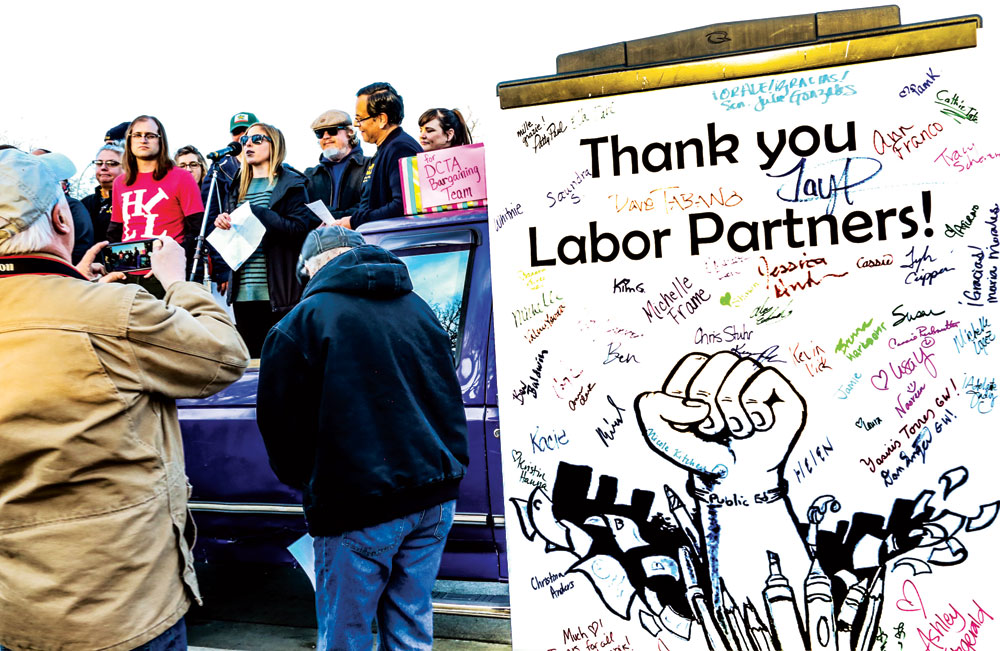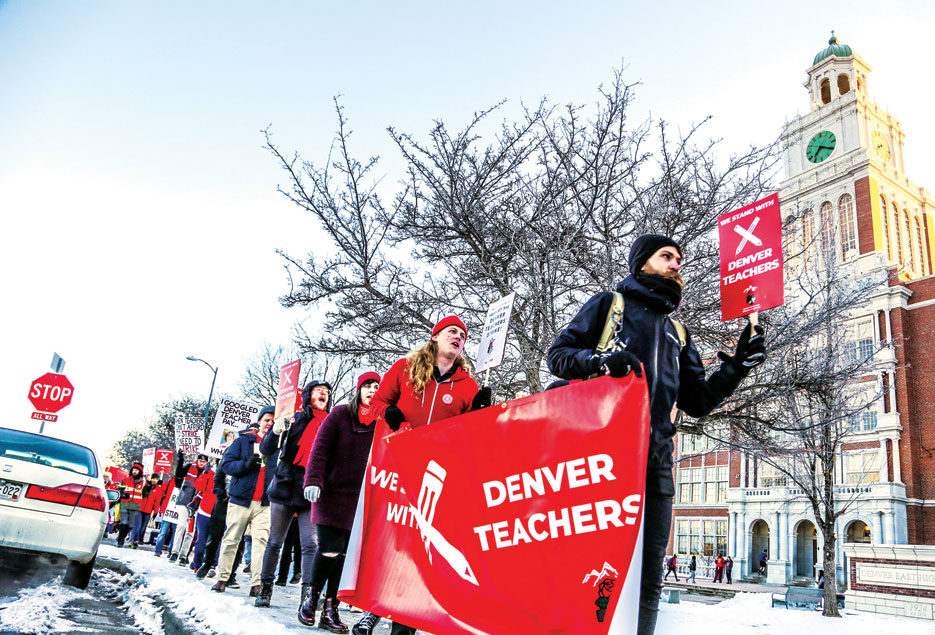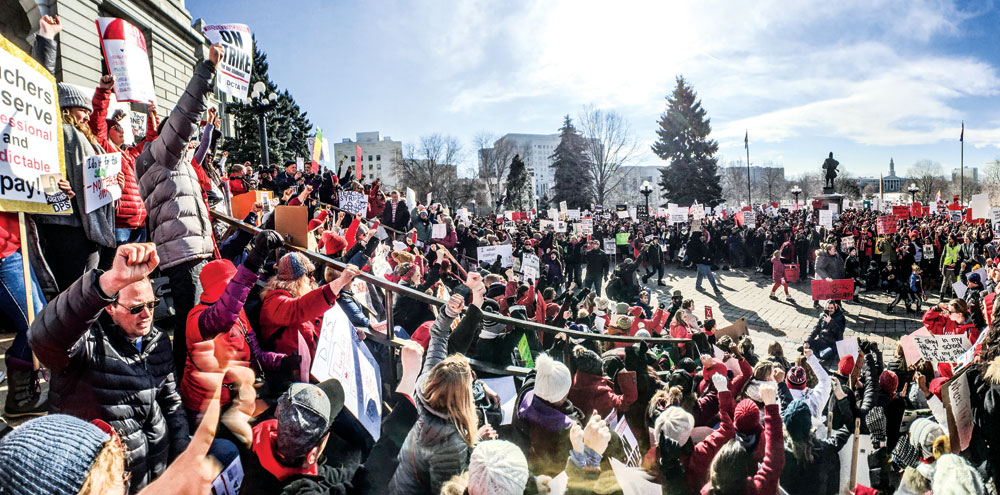
Swigert Elementary first grade teacher Becky Garreau speaks at a City Park event organized by the teachers’ union to thank all who showed support for them during the three-day strike, which ended with an agreement on February 14.
The lead negotiator for the Denver Classroom Teachers Association, Rob Gould, shares his story with the Front Porch: how his years as a teacher-coach helping others become better teachers contributed to his knowledge and passion about the union’s causes; and what went on behind the scenes during the negotiations with DPS.

East High School teachers picket on the first day of the strike.
The Strike: Behind the Scenes
By Monday, February 11, when the teacher strike started, the names Rob and Susana may have become as familiar to Denverites as the names Chuck and Nancy are to political junkies. Two days earlier, on Saturday night, after 15 months of negotiating, Rob and his team decided they had had enough. “What’s it called when you keep doing the same thing over and over and expect different results?” he asks as he reflects back on that night. “Insanity.”

Supporters rally at the Capitol on the first day of the strike.
Rob Gould, lead negotiator for Denver Classroom Teachers Association (DCTA), and his team walked out of negotiations with Susana Cordova when she had barely been in the job of Superintendent of Denver Public Schools for a month. He took some flak for it among observers in the community.

McAuliffe International School teachers are shown here picketing on the first day of the strike.
The Denver Community gained some familiarity with Cordova during her recent superintendent selection process, but who is this person who led 3,900 Denver teachers into a three-day strike and came out with what his team wanted? We asked Gould to talk about his past, the negotiation process, and the future working with DPS. He agreed quickly and was generous with his time.

Lead Negotiator Rob Gould gets (and gives) a hug with a supporter at the gathering in City Park the day after the strike was settled.
Background
Gould has been a DPS teacher for 21 years and he’s been on the union’s bargaining team for 12 years. He has taught special education and special needs kids from grades K through 12. Now he’s a teacher on special assignment—a peer observer and coach working with teachers in his field who have asked for support to improve their skills. He goes to about 50 schools throughout the year.
Starting in 2008, Gould was part of the team working with DPS that developed the teacher-coach role he’s in now. Teachers wanted the people who review and evaluate them to know the job. And, says Gould, “Peer evaluation doesn’t always make them better, you have to have the coaching component.” Gould says the union and DPS worked cooperatively for the first 2-3 years, but then the union felt the administration stopped listening and the system became punitive.
Also during that time he observed three different studies over a 5-year period on whether bonuses and incentives motivated teachers. He says results were mixed. Some said the money kept them teaching, but the majority said working conditions were most important.

The media turned out en masse for a late morning press conference with Superintendent Cordova on the first morning of the strike.
“There’s always been this misconception about unions—that unions are only there to protect teachers. This [coaching and evaluation] is something that we developed over years. It’s not perfect, but we want to support teachers and grow them in their practice….Evaluation is a big deal. Sometimes I have to say to teachers, you’re not at the level we want you to be at. The union is not there to protect bad teachers. The union and the contract are there to make sure that due process is followed and everyone gets a fair shake.”
The Negotiations
Gould’s background had solidified his belief in what the union was asking for. What good would it do to improve teachers’ skills through evaluation, coaching and professional development if the teachers left the district because the salary scale didn’t reward those efforts.
“We’ve had a 20% turnover rate for many years,” he says. “This cause [the strike] was about what teachers are paid. But it was about having experienced teachers in DPS classrooms. It was about recruiting and retaining them. Everyone wants to have the consistency of an experienced teacher for their kid. That’s what this was about.”
After walking away from the negotiations Saturday night, Gould let the first day of the strike unfold. The magnitude of the teacher turnout and community support was overwhelming. He went back to negotiations Tuesday—and by the time he left that night, he felt there was “light at the end of the tunnel.”
What had changed? “Honestly I don’t think the district thought teachers would go out on strike that way … The strike worked. It woke them up. They shifted their thinking around the salary structure … We’re like, ok, you’re finally getting this … We can start moving toward them because they’re moving toward our core principles.”
Gould says the strike was the number one reason they were able to get to agreement so quickly. “…the reality was there … there was a sense of urgency…”
The number two reason, he says, was Kayla Mack, the federal mediator. The two sides had come together 15 months earlier with Mack to do “interest-based bargaining, where both sides come and talk. They tried to work through things with Mack in the role of facilitator. Federal mediators are not allowed to bargain in public, but they can act as a facilitator in public.
“We went through as much of the process as we could with her. And then, when we knew we couldn’t go any further, we needed a mediator. That’s when we had to get a different person. But Kayla was able to get special permission to be the mediator publicly. Because she’d been through so many of the discussions early on as the facilitator, we didn’t have to catch her up … In her role as a mediator, she could poke and prod and do different things to kind of get you to agreement.
“She’s the meanest person you’ll ever meet and the nicest person you’ll ever meet. When she’s in that role as the mediator she can say, ‘Hey look. You’re asking for this. It’s not going to happen.’ Or if you’re asking for that and that’s important to you, ‘Well, you’ve got to look at this piece.’
“Because we have a relationship with her, we trust her. The district has a relationship with her. They trust her. At one point on Wednesday, she’s saying, ‘Why don’t you make the move?’ … I was able to say, “If you can give us the salary schedule that we’re asking for, we are open to your ideas around the incentives.’”
“Kayla was going between the two caucus rooms and carrying back and forth concepts and saying, ‘You, know, here’s this. What about that?’ Or she’d say things like, ‘No that’s not going to work.’ And we’d say, ‘Well, go try it anyway.’ And she’d come back and say, ‘It didn’t work, I told you so.’ In that way, she was able to get us to an agreement.’”
A tentative agreement was announced Thursday morning, February 14—early enough that the teachers went back to school that day. They had achieved what was most important to them: A salary structure with an 11.7% increase in base salary that is fair and transparent and competitive with other districts. They retained their system for professional development. And they agreed to work jointly on a study of retention … “and make sure that our schools of the highest need can retain and attract great teachers.”
The Future
“… we need to build trust. We will get there. It happens over time. It woke up a lot of people to say, ‘These are our schools.’ Not just teachers, not just students, also the community and the parents. We all care deeply about this. Passionately I feel excited about where we’re going.”



0 Comments